Walters Art Museum main entrance
The Walters Art Museum is comprised of three attached historical buildings in the heart of Baltimore’s downtown. Just blocks from the famous Harbor tourist district, the the majority of the Majolica Mania exhibit is installed in the Hackerman House, a 19th century mansion adjoining the Walters.
Hackerman House of the Walters Art Museum
Originally built around 1848 for Dr. John Thomas Hanson in the Federalist style, the building was extensively remodeled in 1892 by Francis Jencks, who updated the building in the Victorian Italian Renaissance style for his own use. After his death, the building underwent a succession of owners until it was acquired in 1990 by the Walters Art Museum who converted it for gallery use.
Hackerman House staircase looking up to the Tiffany dome window
Upon first entrance into the Walters you are greeted by a silhouette of Minton’s majolica peacock.
These silhouettes which are placed around the museum, act as a sort of marker allowing you to find your way through the show. The first ceramic piece you encounter at the entrance is a monumental George Jones majolica calla lily pedestal. The extraordinary detail in the piece is astonishing!
George Jones calla lily pedestal
From the front entrance one needs to travel through a succession of corridors and elevators to reach the main installation of the exhibit in Hackerman House. You enter through a dark corridor with a display of various pieces of majolica in a large case.
Etruscan Majolica corn teapot
Wedgwood majolica dragon handled teapot
Brownfield fish and waves teapot
This brings you into a sunlit inside patio where one encounters a large majolica eagle by Brown-Westhead Moore in front of a cobalt Minton Fountain flanked on either side by Minton heron umbrella stands.
T.C. Brown-Westhead Moore eagle jardiniere
Minton majolica fountain
Minton majolica umbrella/cane stand
Minton majolica umbrella/cane stand
You then see a large Majolica Mania sign with a Minton malachite compote in the center.
Minton majolica malachite compote
From here you pass a wall with a large photo of an interior from H. Victor Newcomb's New York home conservatory with some conservatory majolica in front of the photo.
H. Victor Newcomb house on Fifth Ave. in New York
Image of the conservatory from the Newcomb House
with conservatory majolica
Wedgwood Majolica Rubens garden seat
From there you enter a large room with a pair of monumental majolica jardinieres on pedestals. Numerous other pieces of majolica surround the room. In one corner is a display of garden seats. The Minton peacock stands in the center.
Minton jardiniere and pedestal
Garden seat grouping
Brown-Westhead Moore Egyptian garden seat
Adams & Bromley majolica garden seat
Fielding majolica Fan tea set
There is a large mantel there as well with two heavily decorated Minton figural handled vases with different designs on either side of a Wedgwood clock supported by two mermaids.
On the side is a mantel with three George Jones compotes, unfortunately dwarfed by their placement.
Minton figural handled vase with Theology and Justice
painted in enamels on the body
Minton majolica Poetry & Philosophy after Raphael
To the side is a large entrance way with a winding staircase. At the base is a Wedgwood swan covered urn.
Wedgwood majolica swan urn
There is also a small tribute to Herbert Minton and Colin Minton Campbell and a photo of Léon Arnoux.
Hugues Protât parian sculpture of Herbert Minton (left).
Figure of Colin Minton Campbell, after a bronze statue by Sir Thomas Brock (right)
From here you proceed into another large room showing various aspects of majolica production. There are drawings from the Minton pattern books with the final production pieces in front. There is also a display including an original mold from the Etruscan Works with the resulting majolica Napkin plate, a model of a Minton kiln, Holdcroft crane plates in various colors and a plate with glaze samples.
Minton majolica snake handled vase
with production drawings
decoration attributed to Thomas Kirby
Minton ewer and stand for the Crystal Palace
Art Union with production drawings
Etruscan Napkin plate mold, Holdcroft plates in several color ways,
a glaze formula book from Minton and an experimental plate with various glaze samples.
that revolutionized Minton's production
In the center of the room is a large Minton tiered jardiniere on loan from the Potteries Museum.
Minton majolica jardiniere by Pierre-Émileb Jeannest
George Jones majolica Africa center
George Jones majolica Europe center
One proceeds to a small gallery that highlights the work of various potteries, among them Wedgwood, Brown-Westhead Moore, Forester, Adams & Bromley, Shorter & Boulton, Wardle, Royal Worcester, Brownfield, Copeland and Holdcroft.
The next section dramatically opens with the monumental Minton Prometheus vase framed by Hackerman House's elegant Federal columns.
The next element in the exhibit deals with the use of majolica in the home. In a darkened room, a case in the wall shows a selection of cheese bells from Minton, George Jones, Copeland, Wedgwood and the Etruscan Works as well as a Minton cat jug and Wedgwood butter dish.
Around the room are various decorative and utilitarian serving items by George Jones. Among them: a Jones full nest game dish; a Jones Punch bowl; Jones Egyptian vase; and Jones Marie strawberry server.
Etruscan Majolica Shell wares
From left, the majolica of Wardle, Brown-Westhead Moore,
Adams & Bromley, Forester and Shorter & Boulton
Brown-Westhead Moore swan jug
Royal Worcester, Adams & Bromley and Forster majolica
From left, the majolica of Holdcroft, Brownfield, and Copeland
Holdcroft majolica umbrella stand
Wedgwood majolica display case
Wedgwood majolica Ocean/Shells platter
Minton majolica Prometheus vase
Minton majolica Prometheus vase
Minton majolica Prometheus Vase.
For a brief audio introduction from the BGC to the Prometheus Vase go here
From left to right, Minton cat jug, Copeland primrose cheese bell, George Jones
apple blossom cheese, George Jones bee skep cheese,Wedgwood Luther cheese,
Minton bee hive cheese, Etruscan Lily cheese and Wedgwood butter dish
Against one wall is a group of oyster plates from various manufacturers.
Majolica oyster plates, clockwise from top left, Minton, Wedgwood,
George Jones, Fielding, Etruscan Works, Samuel Lear
and in the center plate attributed to Adams & Bromley
Etruscan Majolica oyster plate
Along one side, on a table in front of dramatic beveled windows are various serving pieces from English and American manufacturers.
Etruscan Majolica Daisy sauce dish
Christopher Dresser designed Wedgwood bowl
Minton majolica lobster terrine
Holdcroft water cooler for Slack and Brownlow
For a brief audio discussion from the BGC of the water cooler go here.
George Jones majolica Marie strawberry server
There is an example of the Jones drum tea service on an adjacent table.
George Jones majolica drum tea set
In the center of the room is an island with various majolica pieces: a Holdcroft pug dog; Wedgwood majolica peacock server, Minton cigar holder; Etruscan Shell humidor; Jones tortoise cuspidor; George Jones spoon warmer; Wedgwood Fly match box, and Brown-Westhead Moore boar game terrine.
Holdcroft majolica pug dog
Brown-Westhead Moore boar game terrine
There is also a monumental Minton game terrine.
Minton majolica game terrine
In the next space is the mammoth pottery workers memorial commissioned by the Bard from artist Walter McConnell, “A Requiem in White”
Memorial to the pottery workers commissioned for the
show, Walter McConnell’s A Requiem in White
We then proceed to the area of the show devoted to American majolica production. Against one wall is a case devoted to the Eureka Pottery of Trenton New Jersey. Many of these designs were copies from Shorter & Boulton.
Eureka majolica
Eureka majolica vase
Fan ice cream tray attributed to Eureka
There are cases devoted to Etruscan Majolica butter pats and the Etruscan Cauliflower, Bamboo and Shell patterns.
Etruscan Majolica butter pats, Sunflower syrup and Celery vase
Etruscan Majolica Cauliflower and Bamboo
In succeeding rooms cases are devoted to other American majolica manufacturers—Arsenal, Carr, Bennett, Haynes & Co.’s Chesapeake Pottery, Peekskill Pottery, and Morley.
Monumental Mayer majolica vase
from the Arsenal Pottery
Haynes Avalon majolica lamp, plate and jar
covered jar for Spaulding & Merrick Co.
the Bennett display at the 1893 World’s Columbian Exposition in Chicago
the Delaware from the Philadelphia Centennial Exhibition
with examples of the Washington pedestal
vase; Tenuous majolica case; Morley majolica case
Tenuous Majolica from the Peekskill Pottery
There is also a large case comparing American majolica ware to its British majolica inspiration.
Wardle President Garfield memorial jug
Copeland majolica eagle vase
Adams & Bromley majolica corn platter
Tenuous Majolica corn platter
Etruscan Majolica Baseball pitcher
Wedgwood majolica cricket jug
Etruscan Majolica cow butter dish
Wedgwood majolica strawberry server
Etruscan Works strawberry server
The show winds down with items relating to the Royal Dairy. A large image of the St. George fountain is next to one of the heron fountains used in both the dairy and the fountain design. The comparison shows the monumental size of the lost 36 ft. fountain.
Design for the Royal Dairy
copied from one at the Royal Dairy
Chromolithograph of the Minton St. George fountain
at the 1862 Crystal Palace Exhibition
Minton heron fountain
Minton heron fountain
Minton heron fountain
The final piece in the show is the Queen Victoria Charger decorated by Thomas Kirby.
Minton Queen Victoria Charger by Thomas Kirby
Minton Queen Victoria Charger by Thomas Kirby.
For a brief audio discussion from the BGC on the Queen Victoria Charger go here
There are also reading rooms at the Walters, video presentations throughout the show, and a space where children can express their own ceramic creations, making it a family welcoming experience. Of course, there is also a gift shop where one can purchase items related to the show.
Brochure of show highlights available at gift shop
The staff at the Walters were exceptionally well informed on the show and very accommodating to the visitors. One of the volunteers was kind enough to lead my group through the various rooms and corridors of the show. I really can't speak more highly of their conscientious attention to the guests.
The Walters Art Museum has received a bequest of 500 pieces of majolica from Philip and Deborah English to be included in their permanent collection. Many of these pieces are shown here and highlight the show.
This is the show's last stop in the United States. The show closes in August and travels across the Atlantic for display at the Potteries Museum at Stoke-on-Trent.
The Potteries Museum
For visitor information on the Walters and the show go to the Walters website.
















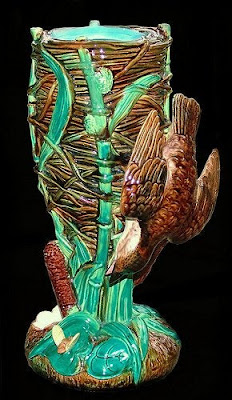









































































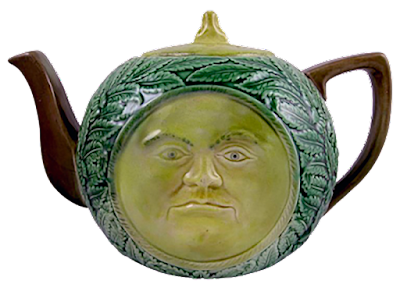











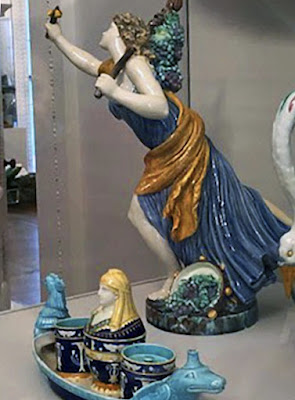






























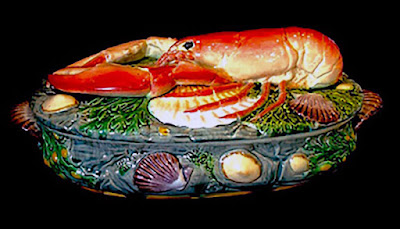



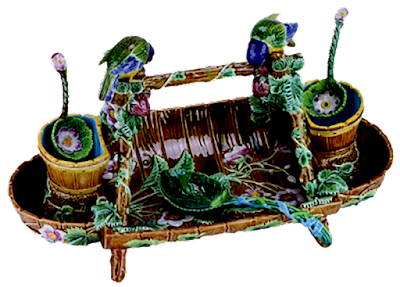
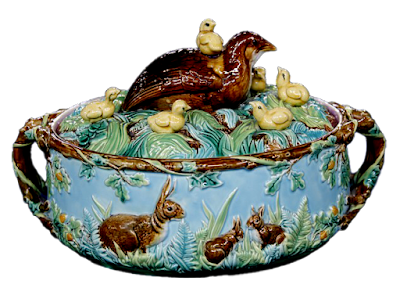

























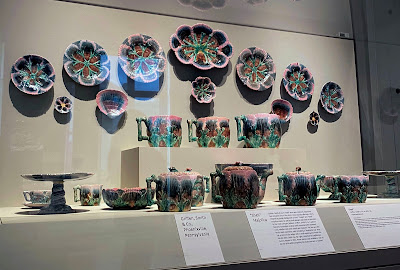



















































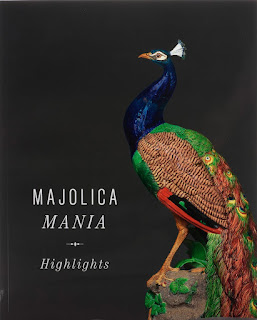



No comments:
Post a Comment